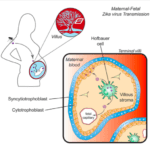In the 27th May 2016 edition of Cell Host & Microbe, scientists have discovered a potential mechanism for the entry of ZIKV into the fetal compartment. Previous studies have shown that the ZIKV is transferred vertically from mother to fetus however the mode of transmission is still under investigation. Research has also shown that the entry of the ZIKV may have detrimental effects to the fetus including abnormal reduction in the size of the head known as microcephaly.
In this study, the authors investigated how the ZIKV strain infects placental macrophages called Hofbauer cells (HCs) and cytotrophoblasts (CTBs) that form the lining of the placenta. In order to determine if these cells were permissive to infection, multiple virologic assays were used. Results showed that both cells were susceptible to the ZIKV infection, however CTBs at a lesser degree. HCs also expressed Type 1 IFN and pro-inflammatory cytokines, suggesting that they are capable of initiating an inflammatory response to ZIKV transmission.
The results from this study demonstrate a possible transport system for the entry of the Zika virus into the fetus compartment by directly infecting placental cells and disrupting the membrane barrier. The authors conclude that “These findings stress the importance of developing antiviral therapies directed against ZIKV replication within placental cells as a means to reduce vertical transmission”.
Quicke, K. et al, 2016. Zika Virus Infects Human Placental Macrophages. Cell Host & Microbe.
